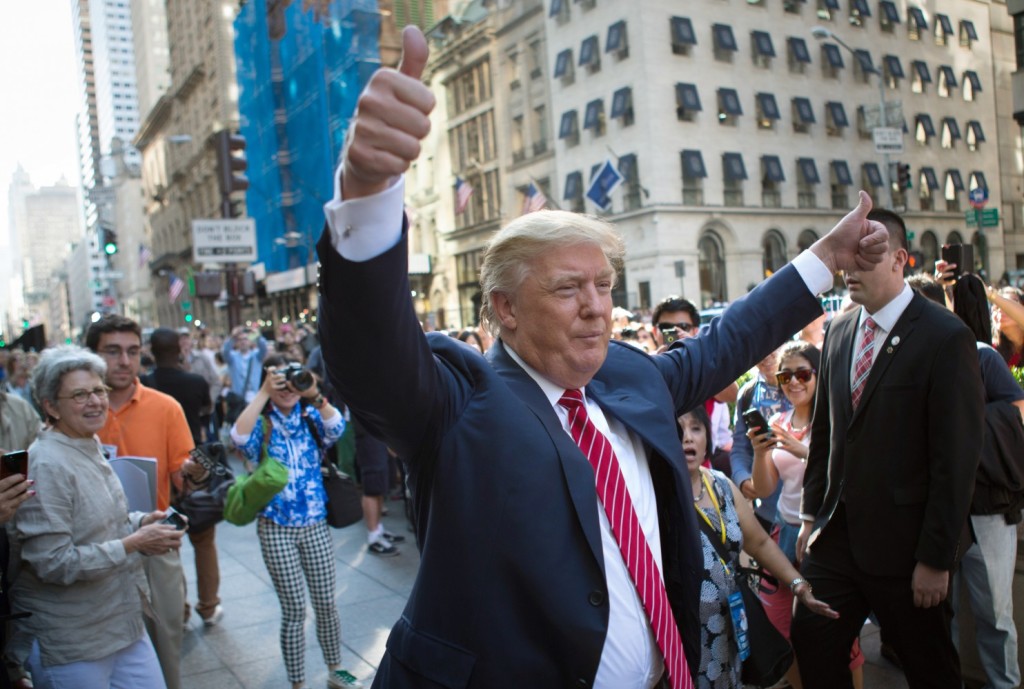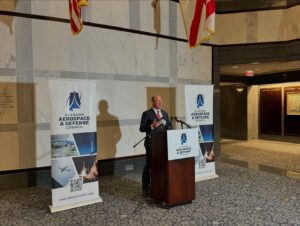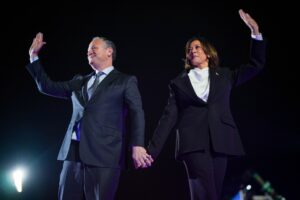Trademarked: Donald Trump makes money off the name ‘Central Park’

Donald Trump is arguably New York City’s most famous resident, and he’s made some of his money off the name of one of the city’s most famous public landmarks: Central Park. The leading Republican presidential candidate first applied for a trademark to use the words “Central Park” on merchandise more than two decades ago, when the park had a far less glamorous reputation than it does today. Since then, Trump has used the nonexclusive trademark to brand furniture, chandeliers, pillows and even key chains. A Trump spokesman declined to say how much Trump has earned from the trademark, but noted the developer’s deep connections to the park. Trump once owned the Plaza Hotel along Central Park South, operates a skyscraper hotel overlooking the park and famously renovated the park’s once-downtrodden ice rink. “Mr. Trump, over the course of his career, has owned and developed some of the most iconic buildings in the city, many of which … sit only footsteps away from Central Park,” said Alan Garten, executive vice president and general counsel to The Trump Organization. Since it is a public space, no one can put an exclusive trademark on the words “Central Park.” But, as first reported by cable news channel NY1, records show that Trump is the single biggest private, for-profit holder of Central Park trademarks on specific goods. It was undeniably a savvy move. His first application came in 1991, when the city’s violent crime rate was near its height and the park often conjured up fears of urban danger. There were 2,154 murders in the city that year, as opposed to 328 last year, and 1991 was just two years removed from the Central Park jogger case in which a woman was attacked and raped while running through the park. According to the records kept by the U.S. Patent and Trademark Office, Trump first received permission to use Central Park for parking garage services, and later expanded the trademark as the park became synonymous with the high-priced real estate that surrounds it in a safer, more affluent New York. A 2007 trademark allowed him to put the park’s name on dozens of Trump-branded furniture and lighting options. Beds, tables, desks, lamps, flashlights, picture frames and throw pillows all bore the names “Central Park” and “Donald Trump.” A glossy, 44-page furniture catalog boasted photos of the “elegant and rich” furnishings with stylized shots of the park and Trump. Many of Trump’s Central Park products are not currently in production, but they can be found in some discount stores and gift shops. The park isn’t the only New York-area landmark on which Trump has filed a trademark. He owns one for “Westchester,” the county north of the city, that was the namesake of a furniture line, and one for “Fifth Avenue,” to label items within his casino business. Trademark experts say it’s difficult to precisely gauge how much a name is worth. “The question would be, how much more likely is someone to buy something called ‘Central Park’ over the name of some other landmark?” said June Besek, a Columbia Law School professor with an expertise on intellectual property issues. “But if people have a positive association with ‘Central Park’ — or a positive association with simply ‘Trump’ — that would clearly be worth something.” The park is jointly operated by the city and the private Central Park Conservancy. Neither has any ability to revoke a trademark from Trump or any other owner. The nonprofit conservancy sells items such as sweat shirts and snow globes, which, unlike Trump’s products, can carry the official park logo. “Nobody has ownership of the words ‘Central Park.’ It is a public space, with a city-owned logo,” said Monica Klein, a spokeswoman for Mayor Bill de Blasio. “When individuals or companies attempt to infringe on city-owned trademarks, we take appropriate legal actions.” The city owns the rights to more than 200 trademarks and stepped up its efforts to acquire new ones and protect existing ones, including the city’s police and fire departments, after demand for their merchandise grew dramatically after the Sept. 11 attacks. When Trump launched his presidential campaign in June with a speech in which he said Mexican immigrants were “bringing drugs” and were “rapists,” the city reviewed millions of dollars’ worth of contracts it has with him, including for a golf course and skating rinks, but found no legal way to cancel them. De Blasio, a Democrat, has said he wouldn’t do any new business with Trump. Republished with permission of the Associated Press.
Influence of churches, once dominant, now waning in South

Prayers said and the closing hymn sung, tea-drinking churchgoers fill Marble City Grill for Sunday lunch. But hard on their heels comes the afternoon crowd: craft beer-drinking, NFL-watching football fans. Such a scene would have been impossible just months ago because Sunday alcohol sales were long illegal in Sylacauga, hometown of both the actor who played TV’s Gomer Pyle and the white marble used to construct the U.S. Supreme Court building. While the central Alabama city of 12,700 has only one hospital, four public schools and 21 red lights, the chamber of commerce directory lists 78 churches. Yet few were surprised when residents voted overwhelmingly in September to legalize Sunday alcohol sales. Churches lacked either the heart or influence to stop it. That shift is part of a broad pattern across the South: Churches are losing their grip on a region where they could long set community standards with a pulpit-pounding sermon or, more subtly, a sideward glance toward someone walking into a liquor store. In metro Atlanta, youth sports teams regularly practice and play games on Sunday mornings and Wednesday nights — times that were strictly off-limits a generation ago because they conflicted with church worship services. In Mississippi, dozens of businesses display anti-discrimination stickers distributed by a gay rights group rather than worry about a church-based backlash. “It doesn’t matter who wants to buy a house,” said real estate agent Diana Britt, who drives around Jackson, Mississippi, in a work vehicle decorated with one of the stickers. “If they want to buy a house, I’ll sell them a house.” Church-based crusaders against gambling also are on a losing streak as all but two Southern states, Alabama and Mississippi, have lotteries. And, perhaps most tellingly, a recent survey by the Pew Research Center showed 19 percent of Southerners don’t identify with any organized religion. That’s fewer “nones” than in other regions, but the number is up 6 percentage points in the South since 2007. The South is still the Bible Belt, and that same Pew survey found that church affiliation remains stronger in the states of the old Confederacy than anywhere else in the United States. Seventy-six percent of Southerners call themselves Christians, and political advertisements often show candidates in or near church. Religious conservatives remain a powerful force in many Southern statehouses. Still, the same South that often holds itself apart from the rest of the country is becoming more like other U.S. regions when it comes to organized religion, said Jessica Martinez, a senior researcher in religion and public life at Pew. And while race divides many things in the South, the trend is evident among blacks, whites and Hispanic adults, she said. “We’ve seen this sort of broader shift throughout the country as a whole with fewer people identifying as being part of the religious base,” she said. “In the South you see a pattern very similar to what we are seeing in other regions.” Thomas Fuller, a religion professor at Baptist-affiliated Samford University near Birmingham, said there’s no single reason churches are losing the cultural wallop they once packed. Migration into the region and the Internet are but two factors chipping away at a society that seemed much more isolated just a generation ago, he said. “The South is not nearly as homogeneous, is far more diverse culturally now than it’s ever been,” said Fuller. “In a way you’re a little hard-pressed now to talk about Southern culture in a singular fashion. It’s not nearly as one-dimensional anymore or easy to describe.” In Sylacauga, 45 miles southeast of Birmingham, Mayor Doug Murphree said the push for Sunday alcohol sales was linked to attracting new businesses. “We’re not really trying to promote drinking in Sylacauga. But if you look at a big chain restaurant like Ruby Tuesday or O’Charley’s, they’re open on Sunday and a big part of their business is alcohol,” said the mayor. Murphree, who attends a Baptist church, said he met with members of the local ministerial association before the citywide vote to explain the city’s economic situation and the need for Sunday alcohol sales. Pastors listened, and by and large they didn’t preach against it. “They said they were not going to try to block us,” he said. So now, Marble City Grill can sell alcohol after 1 p.m. on Sunday just two blocks up North Broadway Avenue from the white-columned First Baptist Church of Sylacauga. “Things have changed,” said Julie Smith, who owns the restaurant with her husband. “We’ve been open 10 years and at first we had people who wouldn’t come because we sold alcohol. They come now.” Around corner from the restaurant, Dee Walker said he’s attracting a larger crowd every Sunday afternoon at his craft beer and wine shop, The Fermenter’s Market at The Rex, named for the old hotel in which it is located. Walker grew up in neighboring Clay County, the last dry county in Alabama, and recalls the petition drives and fire-and-brimstone sermons anytime someone mentioned legalizing alcohol sales. Southern churches no longer have that kind of influence in many places, Walker said. “You’ve got some diminishing populations when it comes to the religious opposition,” said Walker, standing behind a bar with 36 taps for craft beer. Walker said his customers include church deacons and elders; a Baptist layman quoted Scripture while drinking a hoppy brown ale on a recent weekday afternoon. Joe Godfrey, a Southern Baptist minister and head of a group that calls itself “Alabama’s Moral Compass,” recalls a time when churches were the center of Southern society. “I can remember when schools looking to schedule an event would call the local churches to see if they had anything … that might conflict with the school’s tentative plans. If so, the school would find a different date to hold their event. That is no longer true,” said Godfrey, executive director of Alabama Citizens Action Program. “Today, churches try to find a time to schedule their events when ball teams, schools and civic clubs
A round-up of Sunday editorials from Alabama’s leading newspapers

A round-up of Sunday editorials from Alabama’s leading newspapers: The Anniston Star – Ben Carson’s December swoon You remember Ben Carson, don’t you? He’s the retired neurosurgeon who inched his way this fall near the top of Republican presidential polls, a non-politician in the biggest political race on the planet. Not so long ago, Carson was neck-and-neck with New York billionaire and reality TV star Donald Trump, another non-politician, or so he says. Carson was on every cable-news station, in every newspaper, discussed on every political blog, a hot player in a crowded political race. Today, Carson’s campaign has blown a tire. He’s no longer near the top of most GOP polls. Trump, full of hubris and bluster and ego, is solidly in the lead — for now, at least. CNN polling shows Carson 8 points lower this weekend than he was not that long ago. Friday morning, meanwhile, The New York Times detailed two other problems in the Carson camp: the departure of two key staff members and, oddly, criticism of the doctor’s pronunciation of Hamas, the Palestinian militant group. Did he say “Hamas” or “hummus,” a food dip made from mashed-up chickpeas, during a speech in Washington? Only Carson really knows. As for the departure of an adviser and top fundraiser, Carson told The Times, “People come and go, particularly when they feel that things are not being run the way they want them to be run.” The Birmingham News – Gun violence, control and the Left’s true intentions For America’s political Left, the problem in San Bernardino wasn’t terrorism. It wasn’t pure evil perpetrated by extremists. Many liberals see the fundamental cause of the murders in San Bernardino as gun ownership itself. California’s strict gun controls aren’t enough to satisfy them; the truth is that nothing short of state confiscation of firearms ever will be. In the Golden State, an individual can’t sell a gun to another private citizen without a “private party transfer” through a licensed gun dealer. The process includes a background check and a 10-day waiting period. Gun laws are so restrictive that even firearm transfers between adult siblings in the same family aren’t exempt. Buying a handgun is another ordeal entirely. A Californian must prove residency, obtain a handgun safety certificate, demonstrate safe handling, purchase a firearm safety device, select a state-approved handgun, pass a background check, and wait for 10 days before they can purchase. To be clear, that’s just the tip of the iceberg in a state that’s known for its hostile policies towards gun ownership. But take a look at the Left’s responses to the recent senseless shootings in San Bernardino. President Obama called for “common-sense gun safety laws” and “stronger background checks.” In separate remarks, Hillary Clinton noted, “Something needs to be done to prevent gun violence” before yet again calling for “common-sense” gun reforms. One liberal politico or pundit after another will chime in with a refrain long on “do something” and short on specifics. The Decatur Daily – It’s time for reasonable gun control It’s unseemly to discuss gun control in the immediate aftermath of a tragedy, so we won’t talk about the 14 dead and 21 injured in Wednesday’s horrifying attack on a social services center in San Bernardino, California. There are, sadly, plenty of other shootings to discuss. Indeed, if a mass shooting is defined as one with at least four victims including the shooter, there had been 354 in the United States in the 336 days of 2015 before the one in San Bernardino. Every mass shooting leads people to different conclusions on gun control. Advocates of reasonable gun control point out that it works. Other developed nations have more stringent controls on gun ownership, and they have dramatically fewer mass shootings. Others conclude we need more guns, not fewer. We need, as the slogan goes, more good guys with guns. It’s a theory that works in the movies, where the armed protagonist invariably saves the day. In real life, however, it rarely goes according to script. Mass shootings end when law enforcement responds, when the shooter ends his own life or when the shooter leaves. It’s almost unheard of for an armed civilian to foil a mass shooter’s plans. It’s not because of a shortage of gun owners. America has 112 guns for every 100 residents — the highest per capita rate in the world, and almost double that of second-place Serbia. America has plenty of “good guys with guns,” but that does not solve the problem. Despite having the highest rate of legal gun ownership, America has more mass shootings than any developed nation in the world. The U.S. represents less than 5 percent of the global population but accounts for 31 percent of global mass shooters. More than 60 percent of the world’s school and workplace shootings from 1966 through 2012 were committed in America. We produced five times the number of mass shooters in the past half-century as the second-highest country on the list, the Philippines. Dothan Eagle – Midland City officials show poor form There’s an old saying about the process of governing that applies to every legislative body from the U.S. Congress to your local town council: It’s like making sausage, and it isn’t pretty. That was apparent this week during a meeting at town hall in Midland City. District 3 council member George Williams was questioning Mayor Virgil Skipper about who could use town facilities, and grew frustrated because he wasn’t getting the response he hoped for. It didn’t take long for tempers to flare and voices to rise, and when Williams stormed out of the meeting, Skipper directed a police officer present to bar Williams from the building if he returned. That’s a regrettable way to handle the public’s business. Other council members sat silently, looking down at the table uncomfortably while waiting for the storm to pass. Media personnel were present, including a Dothan Eagle reporter who recorded video of the exchange. Both men embarrassed themselves, and owe an


